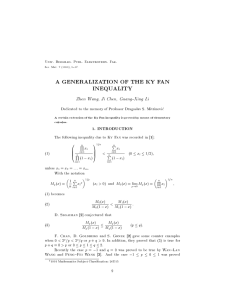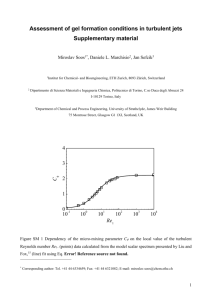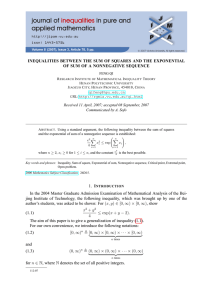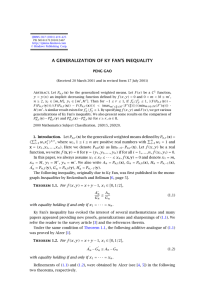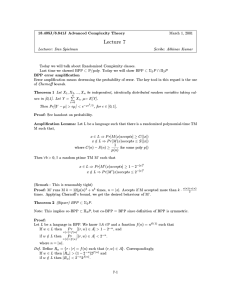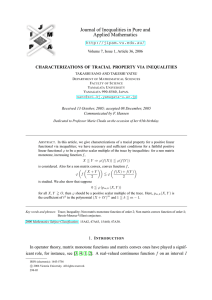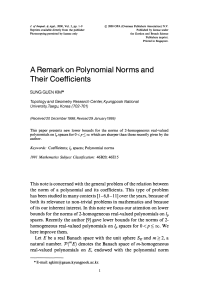Additional Proofs for Joint User Grouping and Linear Virtual
advertisement
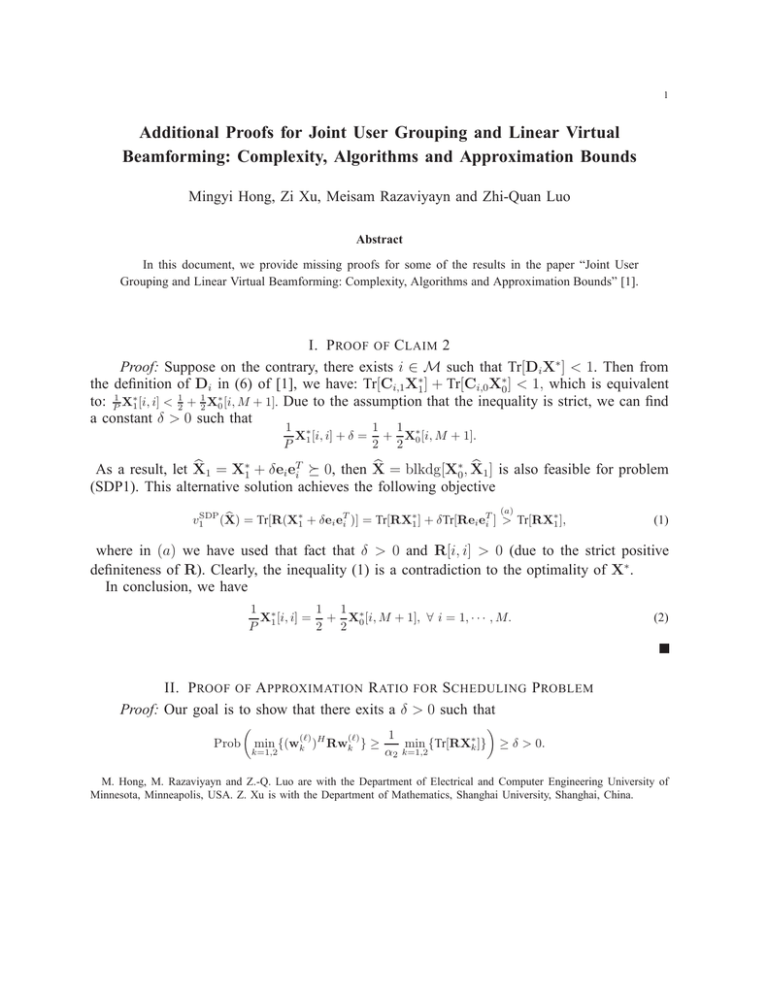
1
Additional Proofs for Joint User Grouping and Linear Virtual
Beamforming: Complexity, Algorithms and Approximation Bounds
Mingyi Hong, Zi Xu, Meisam Razaviyayn and Zhi-Quan Luo
Abstract
In this document, we provide missing proofs for some of the results in the paper “Joint User
Grouping and Linear Virtual Beamforming: Complexity, Algorithms and Approximation Bounds” [1].
I. P ROOF OF C LAIM 2
Proof: Suppose on the contrary, there exists i ∈ M such that Tr[Di X∗ ] < 1. Then from
the definition of Di in (6) of [1], we have: Tr[Ci,1 X∗1 ] + Tr[Ci,0 X∗0 ] < 1, which is equivalent
to: P1 X∗1 [i, i] < 12 + 12 X∗0 [i, M + 1]. Due to the assumption that the inequality is strict, we can find
a constant δ > 0 such that
1 1
1 ∗
X1 [i, i] + δ = + X∗0 [i, M + 1].
P
2 2
b 1 = X∗ + δei eT 0, then X
b = blkdg[X∗ , X
b 1 ] is also feasible for problem
As a result, let X
1
i
0
(SDP1). This alternative solution achieves the following objective
(a)
b = Tr[R(X∗ + δei eT )] = Tr[RX∗ ] + δTr[Rei eT ] > Tr[RX∗ ],
v1SDP (X)
1
i
1
i
1
(1)
where in (a) we have used that fact that δ > 0 and R[i, i] > 0 (due to the strict positive
definiteness of R). Clearly, the inequality (1) is a contradiction to the optimality of X∗ .
In conclusion, we have
1 ∗
1 1
X [i, i] = + X∗0 [i, M + 1], ∀ i = 1, · · · , M.
P 1
2 2
(2)
II. P ROOF OF A PPROXIMATION R ATIO FOR S CHEDULING P ROBLEM
Proof: Our goal is to show that there exits a δ > 0 such that
Prob
(ℓ)
(ℓ)
min {(wk )H Rwk } ≥
k=1,2
1
min {Tr[RX∗k ]}
α2 k=1,2
≥ δ > 0.
M. Hong, M. Razaviyayn and Z.-Q. Luo are with the Department of Electrical and Computer Engineering University of
Minnesota, Minneapolis, USA. Z. Xu is with the Department of Mathematics, Shanghai University, Shanghai, China.
2
Note that we have
1
∗
Prob
≥
min {Tr[RXk ]}
α2 k=1,2
)
!
(
1
1
Tr[R[Sk ]Yk∗ ] ≥
min {Tr[RX∗k ]}
= Prob min
(ℓ)
k=1,2
α2 k=1,2
(t )2
(ℓ)
(ℓ)
min {(wk )H Rwk }
k=1,2
k
≥ Prob
min
k=1,2
{Tr[R[Sk ]Yk∗ ]}
β
1
1
1
1
≥
min {Tr[RX∗k ]}, (ℓ) ≥ , (ℓ) ≥
α2 k=1,2
β (t )2
β
(t )2
1
2
!
.
We first lower bound Tr[R[S2 ]Y2∗ ] by Tr[R[S2 ]Y2∗ ] ≥ Tr[R[S2 ]X∗2 [S2 ]], where the inequality
is from the optimality of Y2∗ as well as the feasibility of X∗2 [S2 ] to the problem (17) in [1].
The right hand side of the above inequality can be further lower bounded by
Tr[R[S2 ]X∗2 [S2 ]] ≥
X
X∗2 [i, i]λM (R)
i∈S2
P λM (R)
=
2
(i)
(ii)
P λM (R)
≥
2
M −Q−
X
!
X∗0 [i, M + 1]
i∈S2
(M − Q)Q
P (M − Q)2
M −Q−
=
λM (R).
M
M
(3)
where (i) is because of the tightness of the constraint (18b) in [1]. We argue the inequality
(ii) as follows. Due to Step S2) of the algorithm, {X∗0 [i, M + 1]}i∈S̄ are the smallest M − Q
P
∗
elements in {X∗0 [i, M + 1]}M
. Combining with the fact that M
i=1
i=1 X0 [i, M + 1] = Q, we must
P
have that i∈S̄ X∗0 [i, M + 1] ≤ MM−Q Q, which further implies (b). Combining the above two
2
inequalities, we obtain Tr[R[S2 ]Y2∗ ] ≥ P (MM−Q) λM (R).
2
Using the same argument, we can lower bound Tr[R[S1 ]Y1∗ ] by: Tr[R[S1 ]Y1∗ ] ≥ QMP λM (R).
Combining the above two estimates, we have that
min {Tr[R[Sk ]Yk∗ ]} ≥ min{Q2 , (M − Q)2 }
k=1,2
P
λM (R).
M
Note that we further have
Tr[RX∗1 ] ≤ λ1 (R)Tr[X∗1 ] = λ1 (R)QP
Tr[RX∗2 ] ≤ λ1 (R)Tr[X∗2 ] = λ1 (R)P (M − Q)
which implies mink=1,2 {Tr[RX∗k ]} ≤ λ1 (R)P min{Q, M − Q}. Consequently, when choosing
β
λ1 (R)P min{Q, M − Q}
λ1 (R)M
=
=
Q
2
2
α2
λM (R) min{Q, M − Q}
min{Q , (M − Q) }P M λM (R)
we have
Prob
min
k=1,2
{Tr[R[Sk ]X∗k ]}
β
<
min {Tr[RX∗k ]}
α2 k=1,2
= 0.
3
Going through similar steps as in Step 2)–Step 3) in the proof of Theorem 1, the final ratio is
α2 =
8M λ1 (R)
ln(12 max{Q, M − Q}).
min{Q, M − Q}λM (R)
(4)
This completes the proof.
III. P ROOF
OF
P ROPOSITION 2
Proof: Below we show the case when R is diagonal. The claim is proved by using a
polynomial time reduction from the equal partitioning with equal cardinality problem. Let M
be a even number and set Q = M2 . Given a vector c ∈ RM consists of positive elements
P
c1 , · · · , cM , let C = M
partitioning with equal cardinality problem finds
i=1 ci > 0, the equal P
M
C
an index set I with |I| = 2 such that 2 = i∈I ci .
Let R = diag(c). We claim that determining if problem (CP2) can achieve an optimal value
of CP
is NP-hard. Let I denote the set such that I = {i : ai = 1} with |I| = M2 . Then the
2
objective of (CP2) can be written as
min
X
i∈I
ci |w1,i |2 ,
X
j ∈I
/
X
X
ci , P
cj |w2,j |2 ≤ min P
cj ,
i∈I
j ∈I
/
where the inequality is achieved by setting |w1,i |2 = P, |w2,i|2 = 0, ∀ i ∈ I, |w1,i|2 =
0, |w2,i |2 = P, ∀ i ∈
/ I. Clearly, checking if we can find an index set I so that this problem
can achieve an objective value of CP
is equivalent to finding a subset I with |I| = M2 satisfying
2
P
C
= i∈I ci , which is exactly the equal partitioning with equal cardinality problem.
2
The case when R is of rank 1 can be shown similarly.
IV. P ROOF OF P ROPOSITION 4
Proof: Assume that fi = 1, ∀i. It suffices to show that checking the feasibility problem
wkH E(ggH )wk
≥t
2 + wH diag (E[ggH ]) w
k=1,2 σn
k
k
|w1,i |2 P0 E[|fi |2 ] + σv2 ≤ ai P, |w2,i |2 P0 E[|fi |2 ] + σv2 ≤ (1 − ai )P, i = 1, · · · , M
min
M
X
ai = Q,
(5)
ai ∈ {0, 1}, i = 1, · · · , M,
i=1
is NP-hard. Let us also consider the following system parameters:
E[|gi |2 ] = ci > 0,
P0 = σv2 = 1,
P = 2,
Q=
M
,
2
t=
1
,
2
σn2 =
X
ci /2.
i
Using the above parameters, one can easily show that problem (5) is feasible iff the following
NP-complete equal partition with equal cardinality problem is feasible:
P
P
Find an index set I ⊆ {1, 2, . . . , M} with |I| = M2 such that i∈I ci = i∈I¯c ci .
Such equivalence completes the proof.
4
R EFERENCES
[1] M. Hong, Z. Xu, M. Razaviyayn, and Z.-Q. Luo, “Joint user grouping and linear virtual beamforming: Complexity,
algorithms and approximation bounds,” 2012, To appear, IEEE Journal on Selected Areas in Communications, Special
issue on Virtual Multiantenna Systems.
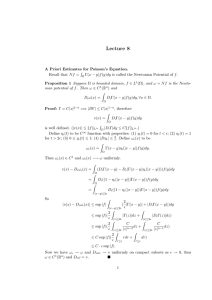
![[A]ω - American Mathematical Society](http://s2.studylib.net/store/data/018049051_1-c0f4be6bde3c21aa6ac2bbf33e04dd05-300x300.png)

